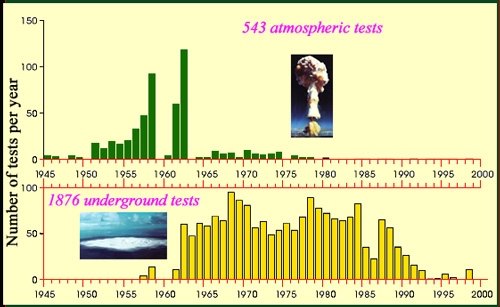A practice that culminates in the 1950’s and 1960’s…
The nuclear tests conducted by the superpowers, especially in the years 1950-1960, were the source of radioactive releases into the environment and have caused, to date, the largest collective dose of uncontrolled radiation. The radioactive contamination still exists, although attenuated by time.

Chronology of nuclear weapons tests
The chronology of atmospheric tests shows that the majority of the tests, mainly American and Soviet, were held from 1951 to 1962 during a dozen of years. From the mutual agreement of 1962 between the United States and the Soviet Union banning atmospheric tests, the underground tests took over. They are, in principle, prohibited since 1995.
© IN2P3
In total, throughout the Cold War and the race for atomic arms, 543 atmospheric tests were conducted. Most of them have been performed by the United States and the Soviet Union, the others by the United Kingdom, France and China.
Following the treaty signed in 1963 between the United States and the Soviet Union banning atmospheric tests, the two superpowers began an extensive program of underground tests until the early 1990s.
Underground tests are not the source of exposure far from the explosion point, at least in the absence of leak or release of radioactivity. Underground programs of France and China continued until 1996. India performed its first underground test in 1974, then five more in 1998, which Pakistan responded a few weeks later by conducting six tests.
Underground programs of France and China continued until 1996. India performed its first underground test in 1974, then five more in 1998, which Pakistan responded a few weeks later by conducting six tests.

Atmospheric and underground tests
The distribution of atmospheric and underground tests between the various nuclear powers shows that most of the tests were conducted by the United States and the Soviet Union, the two superpowers of the Cold War, followed by far by France. Underground tests, which took over banned atmospheric tests after the 1960s, were more numerous but less polluting.
© IN2P3
Although there was an international consensus to ban all types of tests, the CTBT (Comprehensive Test Ban Treaty) issued in 1996, has not yet be fully applied. India, Pakistan, as well as Israel, have not yet ratified it, so that one cannot say that nuclear testing has finally ended. Iran is suspected of a military nuclear program. North Korea has detonated 3 bombs in 2006, 2009 and 2013. Since September 11th 2001, there is a concern about the use of dirty weapons by terrorist groups.
The total power generated by the atmospheric tests was of 440 megatons of TNT, these of underground tests: 90 megatons. The most active years were 1954, 1958, 1961 and 1962. The most powerful explosion is a thermonuclear (H-bomb) Soviet bomb of 50 megatons in 1961, including 97% due to fusion and 3% to fission. In comparison, the powers of the two bombs that destroyed Hiroshima and Nagasaki were much smaller: 15 and 21 kilotons.
The yields of most underground tests were lower than that of atmospheric tests and it was usually possible to contain the debris.

More than 500 megatons detonated
The power generated by atmospheric tests was nearly five times higher than that of underground tests, although they were more than three times as many. Underground tests did not result in direct releases of radioactivity into the environment.
© IN2P3
Americans detonated their tests on the atolls of the Marshall Islands in the Pacific and in the New Mexico and Nevada deserts. The most powerful and polluting thermonuclear test – the Casle Bravo – occurred in 1954 on the Bikini atoll with a yield of 15 megatons of TNT. Soviet sites are located in desert areas of Kazakhstan and Novaya Zemlya in the north of the Arctic Circle. The Soviets also made several unsuccessful attempts to use nuclear explosive for civil engineering. France conducted most of its underground tests on the atoll of Muruora.
Other articles on the subject « Military Applications »
Nuclear Weapons
Atomic and thermonuclear bombs There are two types of nuclear bombs: the atomic A bombs and the t[...]
The 1945 A-bombs
Little Boy and Fatman The United States had available three bombs in July 1945: two made of pluto[...]
The Franck Report
The Scientists who opposed dropping atomic bombs on Japan In June 1945, shortly before the atomic[...]
Nagasaki
A Japanese account of the Nagasaki bomb Atomic bomb, rescue and relief report, a poignant small b[...]
Nagasaki First Aid
Extracts from Doctor Takashi Nagai first report In this first rescue report intended for the auth[...]
Atoms for Peace
1953: Eisenhower’s initiative for peaceful use of the atom After the Second World War, The [...]
Atomic Tests Fallout
An embarrassing legacy but alleviated with time Radioactive fallout differ significantly accordin[...]
Arsenals reduction
A modest step towards a reduction in nuclear arsenals During the Cold War, the United States and [...]